In the preface to his book of essays, “L’Envers et L’Endroit” (“The Wrong Side and the Right Side,” 1958), Albert Camus wrote:
I know this with sure and certain knowledge: a man’s work is nothing but this slow trek to rediscover, through the detours of art, those two or three great and simple images in whose presence his heart first opened.
Most people cannot claim the mantle of artist. Still, most of us face the same urge to recapture early joys. This is sometimes disparagingly referred to as “reliving your childhood.” You see it at baseball games, where old men sit in the stands vicariously joining in the play on the field. You see it when a new mother selects a first doll for her daughter. You saw it last year when many Americans who, 40 years before, had joined Robert F. Kennedy in his improbable and sadly aborted 100-day quest for the Presidency, found themselves rejuvenated by another political campaign powered by hope and renewal.
I love snow for a simple reason: it instantly transports me back to childhood. To capture that feeling and make it available in every season, I collect art depicting snow in the city. One of the pieces in my collection is this 10-by-12 inch oil sketch, “Drifting Snow,” dated 1910, of an intersection in Philadelphia:
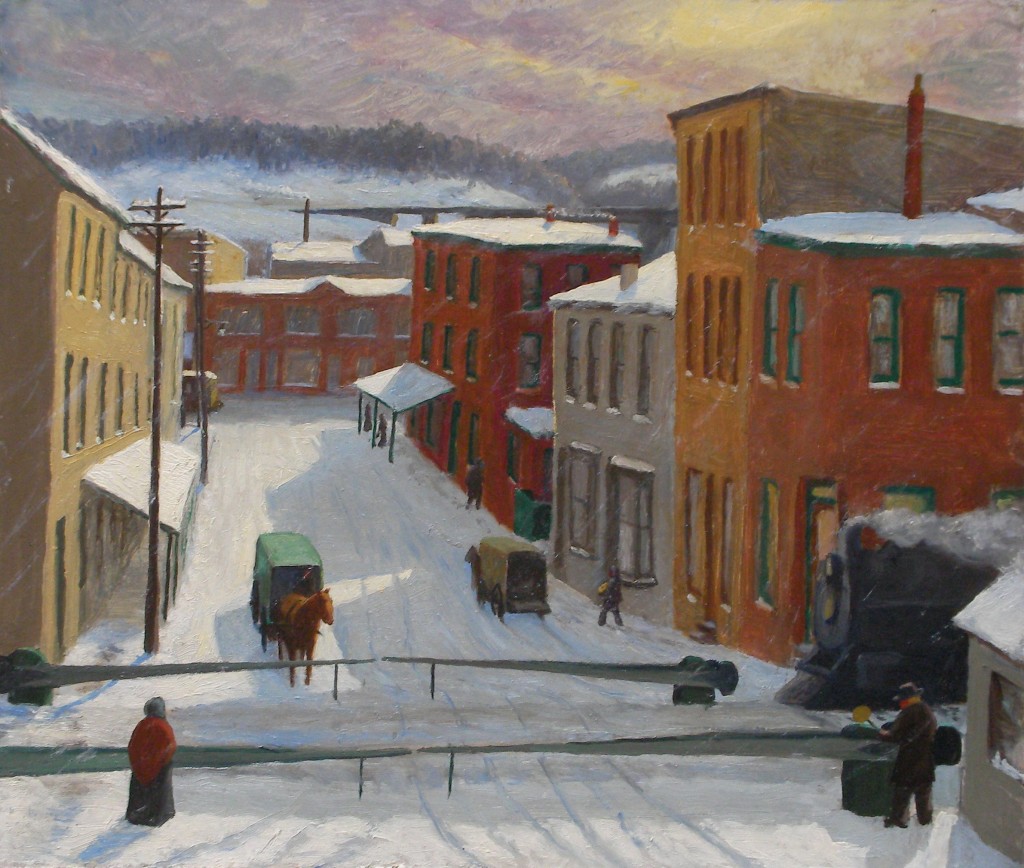
The artist, James A. Jefferys, lived in the city’s Manayunk neighborhood. He indicated the scene’s location in a hand-written inscription on the verso: “Drifting Snow. Sketched from 2nd floor front Room of H.D. Richards showing R.R. Gate Tender at Cresson & Short Leverings St Manayunk Phila 2-14-1910 By James A. Jefferys [?]20 Grape St”. To 21st century eyes, the picture’s most interesting detail may be the train engine entering from the right. There’s something odd about this vision of a train encroaching on an urban streetscape normally reserved for less daunting vehicles. It puts me in a surrealistic mood. I’m ready to imagine the train’s next stop is someone’s living room, as recorded in Magritte’s painting, “Time Transfixed.”
Historical notes: In 1929-1930, Reading Railroad replaced the Cresson Street train tracks with an elevated structure. The name Manayunk is derived from the Lenape Indian word “manaiung“, which means “river” or “where we go for drink.” Manayunk is an old blue-collar industrial neighborhood (textile and paper mills thrived in the 19th century) currently undergoing gentrification. It rises from the banks of the Schuylkill upriver from Wissahicken Creek, a few miles from center-city Philadelphia.
As for the artist, a Google search uncovered only sparse information about James Jefferys’ presence in Manayunk. Geneology sites contain references that supply birth and death dates of 1889-1969 and show his continual presence in Philadelphia (interrupted by service in World War I). Yet I’ve found nothing about his activity as a painter; no records of his artistic training, exhibitions, or awards. Possibly he was a self-taught artist. The 1910 painting shows a careful but tentative hand of a novice painter (he was only 21 at the time) uninfluenced by academic training. He kept painting, though. Possibly he worked in a related field such as sign-making, illustration, advertising or publishing. This early sketch reveals an intuitive sense of atmosphere and color. To my taste the painting is pleasing and very American.
Three years after buying the snow sketch I came across, at auction, another painting by Jefferys that I thought would be a fine addition to the collection. I was happy to place the winning bid for this 1938 oil on canvas:
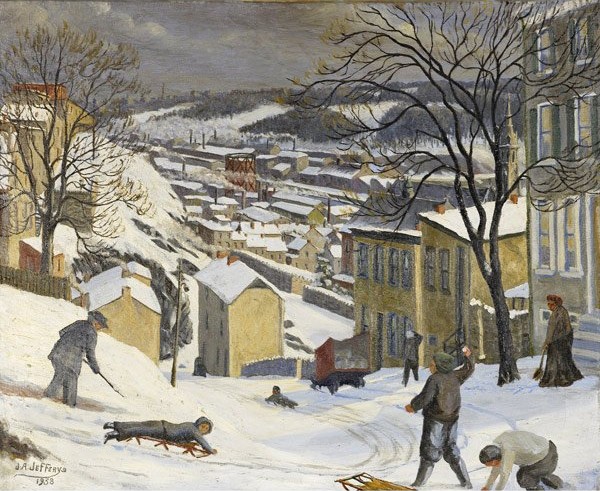
[Boone and Grape Streets, Manayunk, oil on canvas, 1938, 20 x 24 inches, signed and dated lower left recto; inscribed on verso: “Boone & Grape Sts / J.A. Jefferys / 4310 Terrace ST / Myk PA”. Rago Arts and Auction Center, Lambertville, NJ, Fine Art Auction, May 15, 2008, Lot 226.]
Jefferys’ note on the verso of the smaller snow scene, done nearly three decades before this painting, placed his residence somewhere on Grape Street. This means he would have been very familiar with the street’s trecherous upper reaches, depicted here. The Terrace Street address listed on the back of the 1938 work places him just two short blocks from Boone and Grape. I imagine him walking out the front door of his modest row house one cold day during the Great Depression, turning left up Terrace Street. A few steps into his trek he thinks twice about whether to take a detour down the steep Cotton Street steps leading directly to Boone. He decides to keep on the safer sidewalk, on up to Grape Street, where he turns left to make the final trudge downhill to the intersection at Boone. There, in front of him, is a scene of immediate activity and distant calm. He is glad to have come upon something demanding to be captured on canvas.
What were Jefferys’ working methods as an artist? Did he do a pencil sketch then and there? Did he bring a camera? Or did he leave the house carrying a fresh canvas, easel, and plein air materials, instinctively knowing this would be a productive day?
If you stand at the same vantage point today, as you can do in absentia thanks to Google Maps Street View, it is clear Jefferys took some liberties with distant perspective, bending space to create a more thrilling atmosphere. That is what artists do.
Repeating elements seen in his 1910 sketch, the upper portion of the picture features mills and factories, the soft hills beyond the river, and finally a spacious wintry gray sky. But Jefferys’ talents have moved well beyond the primitive mode of 1910, now embracing a style similar to that of John Sloan and of a younger cohort of social realist painters who emerged in the 1930s. He has well captured in paint a landscape cushioned in white, the cold air alive. He introduces a stronger narrative. The foreground tableau is a tale of play and toil, where boys’ shouts compete with the muffled metalic scraping of shovels handled by the old man at left and old woman at right. Tiresome work is consigned to the margins, peripheral to the central energy of sledders, who evade a snowball fight and zoom like dare-devils deeper into the world.
I am struck by how the composition, whether by chance or intention, is so reminiscent of one of the most beloved paintings in art history, Bruegel’s Hunters in the Snow.
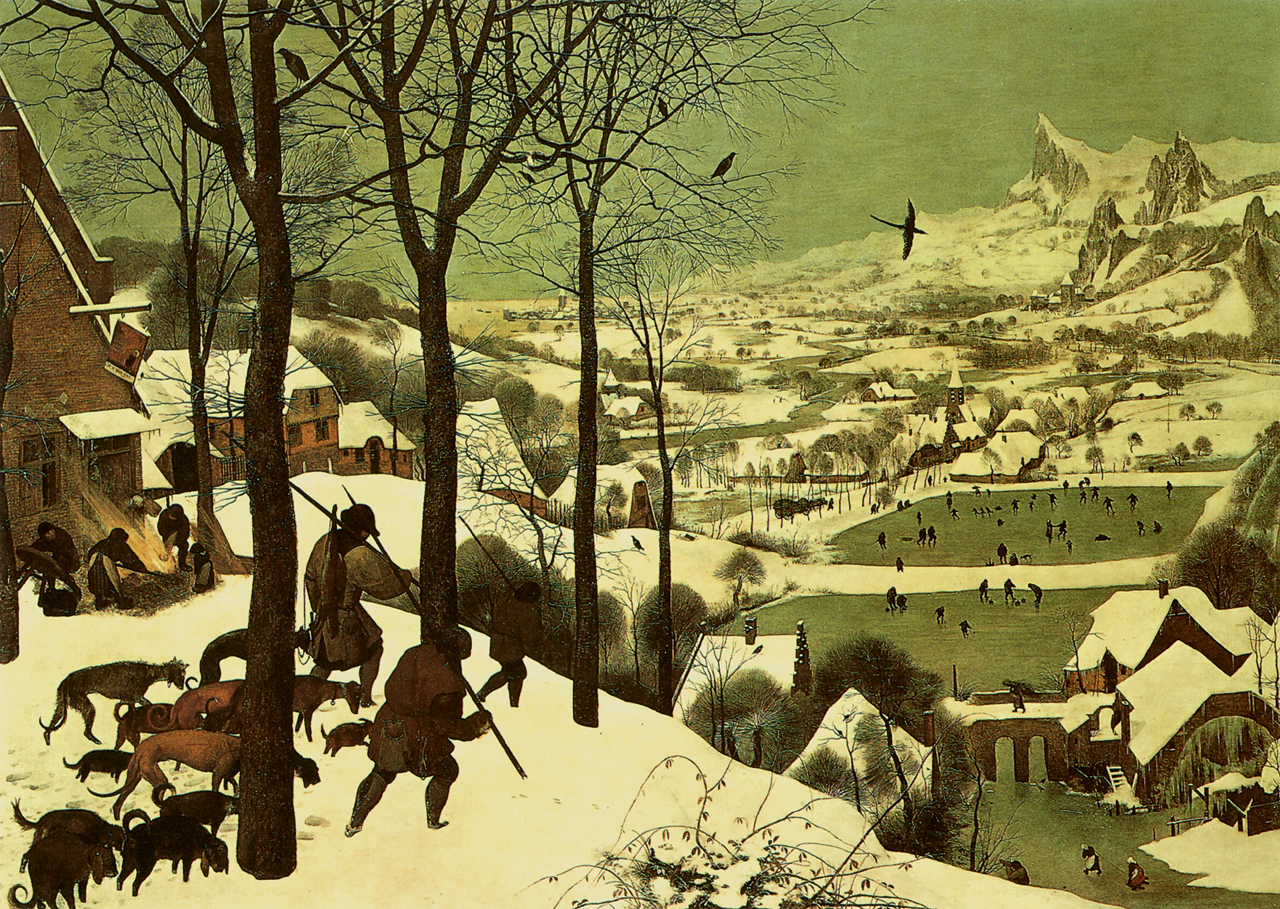
In an interesting online essay entitled, “How Can We Be Composed?- Bruegel’s Hunters in the Snow,” Nancy Huntting quotes from Eli Siegel’s commentary in Art as Composition:
“Pieter Bruegel’s Hunters in the Snow is a picture that tells us, Everything can be composed. Lines can be composed. The general direction of the picture is at a slant, or diagonal; the trees are assertively vertical; there are horizontal lines with the snow. Varying white shapes differ and coalesce. Houses, as volumes, mingle with snow as weight, and with space. Birds are diagonal, vertical, horizontal. The immediate in the picture mingles with a various middle ground, and a spacious, rising, misty background. Here is reality’s plenty caught hold of by Bruegel and arranged.”
Siegel’s formal analysis helps explain why a painting is so arresting. But it forgets the power of the sentimental elements (using the “s” word in its non-pejorative sense) of a painting — elements which, to an opened heart, provide pleasures all their own.
___________________________________________
UPDATE (August 2009)
In the Comments section, below, you’ll find an email from the artist’s grandson, Jim Jefferys, who came across this blog posting and wrote to me in June, 2009. A few months later he sent along some photos and these additional information about his grandfather’s artistic efforts:
“The first picture is a snow scene with a chimney in center (oil on canvas, rather large – 36 inches square). This painting was to be given to the first male Jefferys in each generation. After me it goes to my son. … The painting I’m told was a fireplace that my great, great grandfather built when he came to this country. The building, after years and years of neglect, is the way my grand father saw it and painted it on a snowy day. A lot of his snow scenes were painted outdoors when it was snowing. My aunt can tell you he would take her as a little girl sledding in Manyunk, with oils, brushes and easel in tow. So, that’s the answer to your one question — he did paint in the snow.”
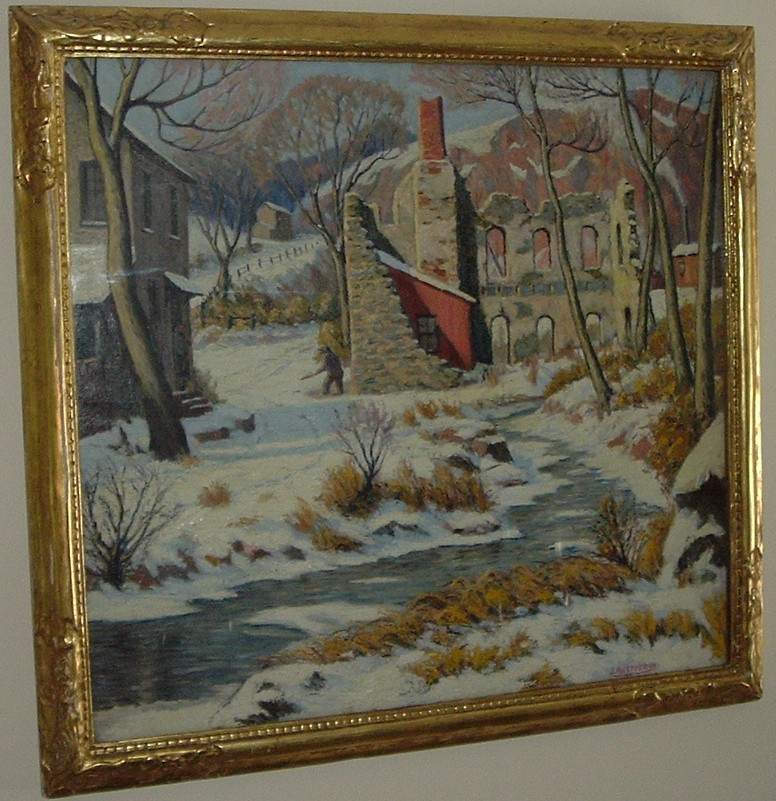
“The second picture is the old Mill inn in Hatboro PA. which still stands to this day. [Note: unfortunately, the JPEG file for this painting could not be opened.] I was born and raised in that area. This building is still there and even though it has had renovations it still looks the same. The painting (watercolor) was completed on the day I was born. It was given to my father the next day for him to hold for me. Third picture (oil on canvas) is of Valley Green in Fairmount Park, Philadelphia. The building still there today and looks the same. I used to go trout fishing there when I was 16 years of age. It was one of my father’s favorite pictures.”
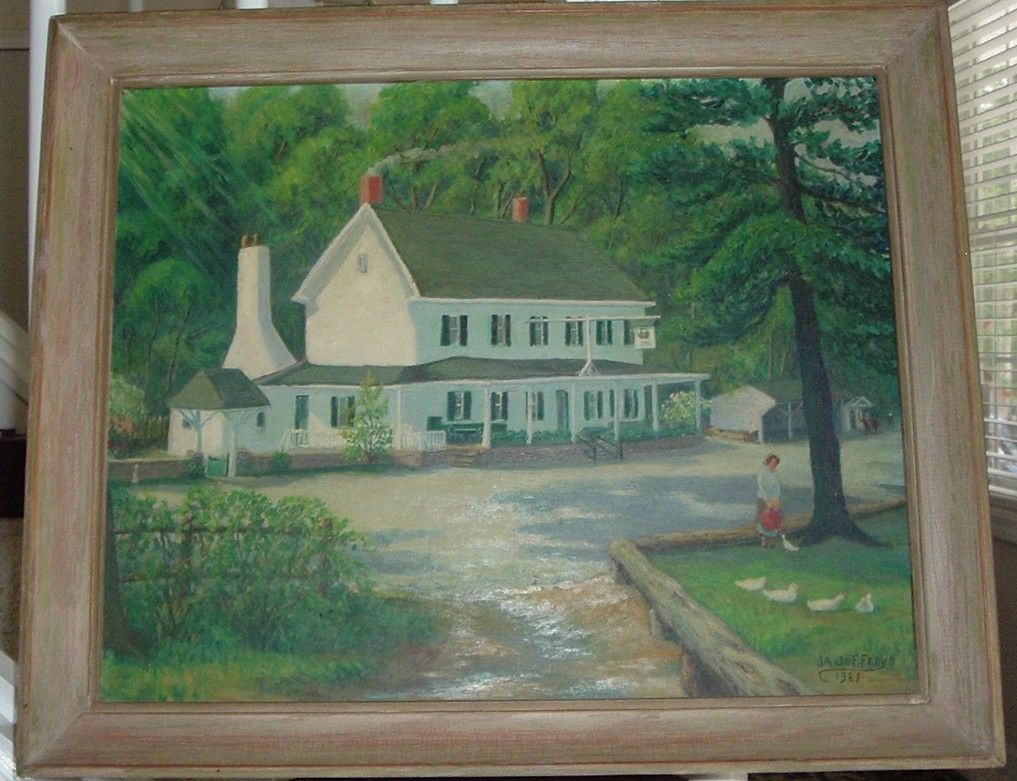
“Fourth picture [JPEG file was not openable] is a castle in Germany he did during WWI (oil on canvas). He also did a portrait of Von Hindenburg when he was there after Germany surrendered. That picture is around somewhere, as one of the relatives has it. Fifth picture [JPEG file not openable] is a small painting of a run-down farmhouse (oil on canvas). I don’t know anything about it, just that I liked it and my grandfather gave it to me after I graduated from high school. Sixth picture is a watercolor of Dad’s Place in North Wildwood, NJ. It is still there and I was with my grandfather when he started the painting , back when we did not have bug spray for green flies, etc. I asked for the painting and he gave it to me. He knew if he gave it to me I would not forget the good times I had going to the shore with him.”
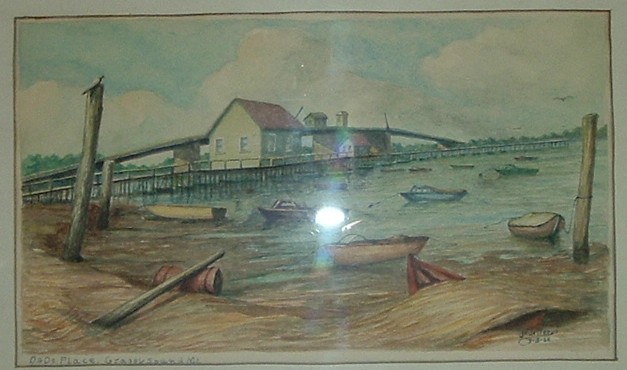
“Seventh picture is down the shore somewhere, probably the same area, but this home is probably gone from storms now. It was a twin set (my sister has the other) and was painted the same summer as the Dad’s Place picture.”
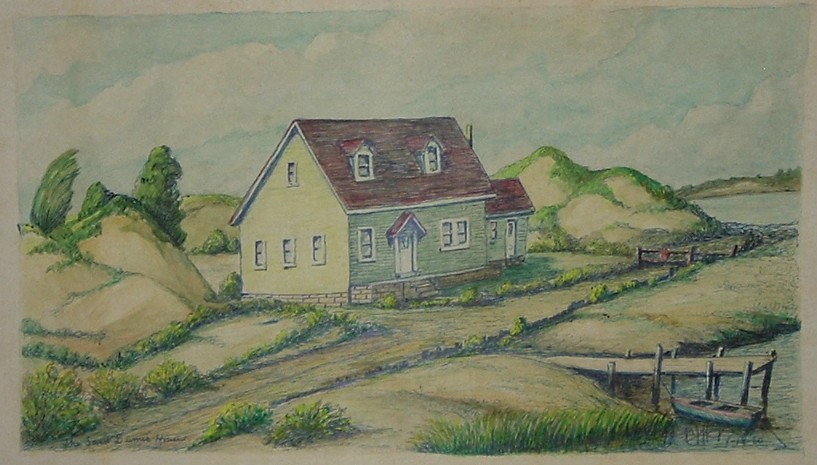
.
UPDATE (September 2014)
Here are photos of a 1942 watercolor by the artist, depicting the church and rectory of Saint John the Baptist in Manayunk. These photos were provided to me recently by Rev. John J. Kelly (see Comments section) who found the picture in a back room of the rectory. He writes: “The painting is quite realistic and a fine depiction of Rector street. On the left is Saint John’s, two schools and the Church which still stands. On the Right is the Rectory which still stands; so too do the walls at the top of the street and on Rector street. It appears that the houses are all still intact. What is noticeably different is at the bottom of Rector street there is no high wall and SEPTA train tracks are missing from the painting.”
.
.
.
For comparison purposes, below is a detail of Jefferys’ 1938 painting, Boone and Grape St., Manayunk, showing the spire of Saint John the Baptist church and the roofs of two schools, from a higher perspective.
.
.
UPDATE – April 2015:
A new Google search for “James A. Jefferys” uncovered additional biographical information. The future artist was born in March of 1889 and died in July of 1969. The year 1938, when Jefferys painted the snow scene he titled Boone and Grape Street, Manayunk, shown at the beginning of this article, was a year of tragedy for the artist. In 1938 he lost both of his parents: (James Jefferys, 1851-1938) and mother (Anna Judge, 1864-1938).
The July 18, 1969 edition of the Des Moine Register newspaper published a short obituary for James A. Jefferys. It provides intriguing details about the artist’s early years:
“James A. Jefferys, 80, a portrait and landscape artist who painted European royally at the front during World War I, [died] in Philadelphia. He painted portraits of King Albert of Belgium and the Prince of Wales and later Edward VIII when they visited the front. He also made pen and brush sketches of battles.”
Tags: 1910, 1938, 1942, 4310 Terrace St, Albert Camus, Boone Street, Bruegel, church, Cresson, Cresson Street, Eli Siegel, Grape Street, H.D. Richards, How Can We Be Composed?, Hunters in the Snow, James A. Jefferys, John Sloan, Levering, Levering Street, Magritte, Manayunk, Nancy Huntting, Obama, Philadelphia, R.R. Gate Tender, rectory, Robert F. Kennedy, Saint John the Baptist, Schuylkill River, Short Leverings, sledding, snow, social realism, St. John the Baptist, Terrace Street, Time Transfixed, weather, winter
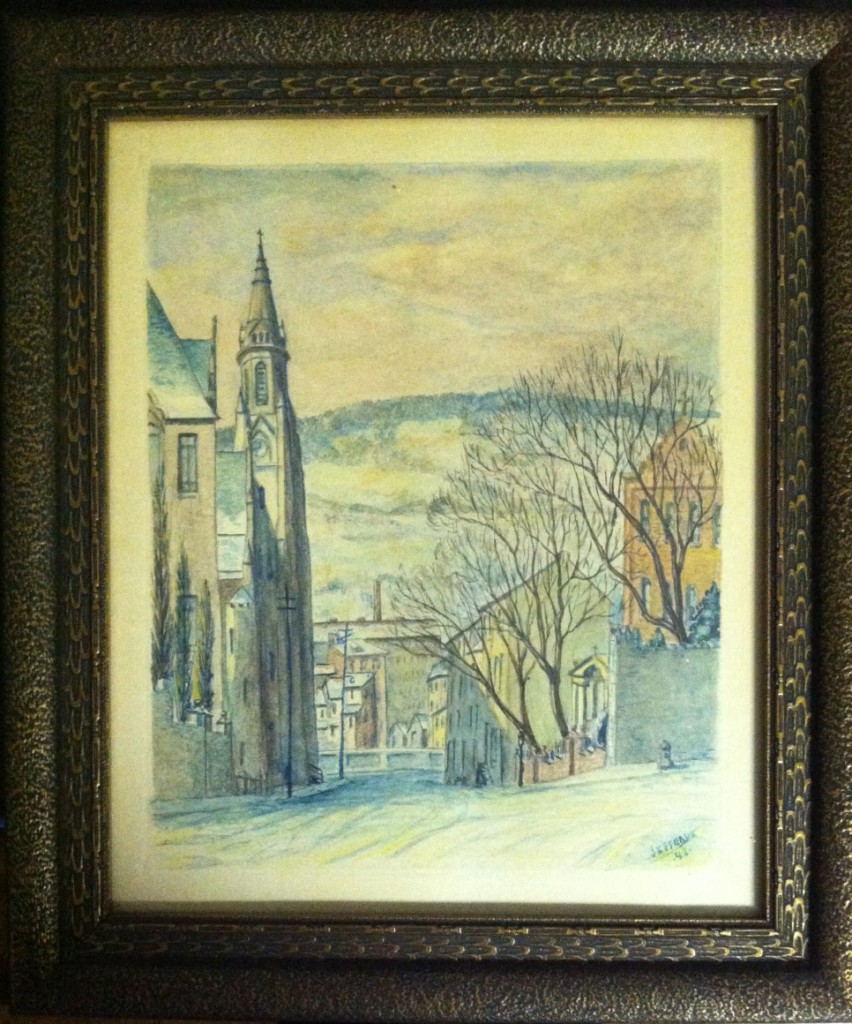

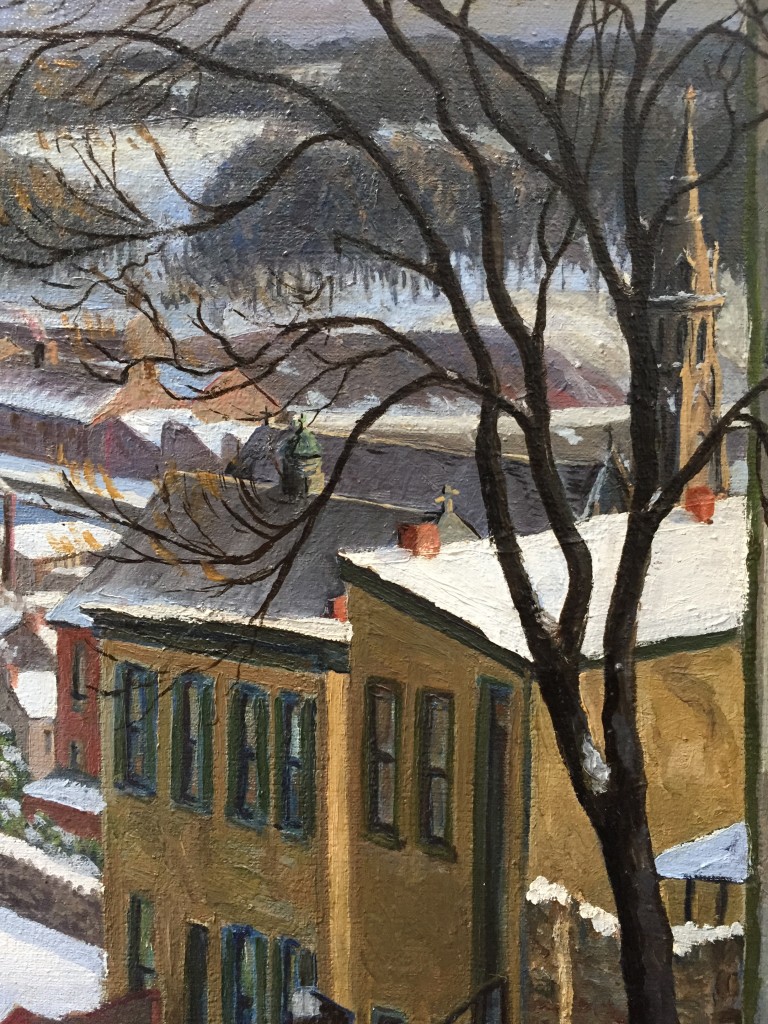
Mike, My grandfather is the artist James A. Jefferys. While I only saw my grandfather actually work when I was younger (age 9 to 17) he did oil, watercolor etc. He did work from sketches and from just packing up the easel and going to the site he wished to paint. I have fond memories of my grandfather picking me up on a thursday morning and driving to Wildwood NJ where he stayed for the summer season painting seascapes and portraits for people. He stayed with my Uncle who passed away a long time ago. He had three children, two boys and a girl. My Father and his brother passed away years ago , my aunt is still alive. She can answer any questions you might have about him. He was one of the Founders of the Manyunk Art Alliance and had several personal showings of his art along with other local arttists from the area. If you would like to speak with my Aunt I will contact her for you. There is a lot of his works out there and I always knew that sooner or later he would be discovered. Thanks Jim Jefferys
[Note from Mike Ettner: Mr. Jefferys also submitted a comment on June 29, 2009 at 8:24 am to a different posting of mine; his second comment is found at https://www.mikeettner.com/06/2009/ray-grathwols-busy-corner-akron/. It is reproduced immediatedly below.]
Mike, My name is Jim Jefferys and the artist James A. Jefferys was my grandfather. He had two sons and a daughter. My father and Uncle are deceased. My aunt is alive and well. She could answer many of your questions much more accurately than me or my sister or for that matter all his grandchildren. All of us have paintings and I would add my grandfather was very generous with his works. I have fond memories of my grandfather picking me up on a thursday back in the middle 50’s and taking me to Wildwood to my Uncle Jims rental house where my grand father painted seascapes and portraits for people. i have info from newspapers on my grandfather that gives a biography of his life which we can send to you. Let me know if you would like the info and if you would like to talk to my Aunt I will contact her to see if she would make herself available for questions. Thanks Jim Jefferys
Jim,
Thanks for your comments offering additional information about your Grandfather, James A. Jefferys. I’ve sent a message to your email address and hope to hear from you. Thanks.
Mike Ettner
my email: mikeettner@aol.com
Jim
We are very interested to ask you if you have a family tree back to South East England?
We are related to the Canadian artist C.W.Jefferys and although I have not yet confirmed the paper trace link. We suspect a connection to James Jefferys ( Maidstone) James Jefferys (1751-1784),
Do you have that link? I believe the artist genes are present with your grandfather as well.
Marja Allen
I am James A. Jefferys’ granddaughter — daughter of the “aunt” my cousin, Jim, references above. My mom is now 82 years young.
For many years during elementary school, I walked to my grandfather’s house to have lunch with him each day. And, yes, my grandfather told me about his cousin named Charles Jefferys who lived in Canada; told me he was a stained glass artist — my grandfather corresponded with him by mail. My grandfather’s family was indeed from Maidston, and his dad’s name was James. I saw at Ellis Island that a James Jefferys emigrated to the states in the 1800’s — not familiar with your dates “1751-1784”.
He lived his entire adult life on Terrace St, not Grape St — I believe his friend, Mr. Richards, lived on Grape St. He grew up as the third of eleven children on Fleming St (just “up the street” from his home on Terrace).
Feel free to contact me via email if you like.
Wini
By the way, the “farmhouse” in the painting above is actually Valley Green Inn in Chestnut Hill, PA which still exists as a very popular continental restaurant and banquet venue – it is aside the Wissahickon Creek – and the location of my wedding reception in 1971.
Hi Wini,
Please say give my best wishes to your Mother I have not seen her for a very long time. I think your father was our TV Repairman for many years back when you could get someone to come to the house and repair a TV. I remember visiting Uncle James on Terrace Street and sometimes watching him work. At the time we lived at the house on Fleming Street.
Hi! I came upon your blog while doing a google image search for a business in Manayunk. I was scrolling through the images and the painting of Boone and Grape St came up without showing the title. I was admiring the painting for just a moment when it struck me that it looked VERY familiar. The house on the very right edge that is three stories high is my house! My husband and I bought it in 2006, and lived there until this year, it’s now rented out. The stone wall that runs along the left side yard is still standing. I love seeing historical photographs and paintings of the house as it’s one of the older ones on Boone Street. Estimated built in late 1800’s on the title.
Feel free to email me!
Leslie,
Glad to hear you came across this post and could see your property as it was 70+ years ago. Can you still see down into the valley and river from the point where the artist stood? If you ever have a chance to photograph the scene from his vantage point, I’d appreciate seeing the result (and will post it here).
Best,
Mike
Information to correct:
Wini Curcio refers to a cousin of her grandfather, Charles Jefferys, living in Canada and mentions that he was a stain glass artist.
There were a few cousins who had moved to Canada, Charles William Jefferys ( My husband’s grandfather) being one of them and he designed at least 2 stain glass windows while his brother Walter did the execution of the stain glass windows.
We do have 2 stain glass windows designed by Charles W. and made by Walter Jefferys dated 1915. We would love to find out where and if there are other windows.
Charles W. Jefferys was a historian, illustrator and artist.
Do not post the following:
Please ask Wini Curcio to contact us.
Thanks
Hey All,
James A. Jefferys was my great uncle. We have a number of his paintings hanging here in our house in Sun City West, Arizona. The most prominent of which is a wonderful huge 3’x4′ painting dated 1959 of a church that my mom thinks might be St. Thomas with the Presidential Apartments in the back ground where my Grandfather Walter Thomas worked for many years.
[…] Most humbly he begins and closes the lecture with reminiscences of childhood, what he calls the time of “dreaming, reading, and writing.” When I read these passages I was reminded of a remark Albert Camus made in his maturity, a statement I’ve long been fond of: […]
I am so pleased after more than 50 years to have found information on Mr . Jefferys. As a small child I stood behind him as he painted scenes of Manayunk from Terrace and cotton St. I lived with my Aunt, Marie Monaghan at 4323 terrace. for years now I have been looking for paintings of his and have not found any, nor any information about him. He tolerated my looking over his shoulder and I envied his Daughter Winnie for having this great talent in her home. I would welcome more info on him and where his works may be found.
Marie,
Thank you for your message. Everything I’ve been able to find out about this artist — including information from his family — I’ve included here in this blog post. I’m always hoping others will send me additional material.
Best,
Mike
Greetings Mike
I have what appears to be a watercolor signed Jefferys -42-
It depicts Rector street in Manayunk. It is a downward view with Saint John the Baptist Church on the left and the Rectory followed by row homes on the left. In the center is an old factory with an active smoke stack.
Can you tell me anything about this watercolor. I presume it is the same Jefferys that the blog is about.
Thanks
John
Mike
I just sent a comment about Rector street watercolor and I forgot to add my contact information. He is my email.
revjohn52@Hotmail.com
John – Can you send me a digital photo of your watercolor to post here on the site? The best way to confirm that the picture you own is by the same artist is, first, by the signature (does it appear to be by the same hand) and second by the style of the work (again, is your picture consistent with the realistic manner, colors, perspective, composition, etc. of the other Jefferys works posted here?
Thanks for your message.
Best,
Mike
Hi Mike, can you send me an e-mail address or phone # where I can contact you. It is in regard to the Manayunk paintings in your collection. Thanks.
Greetings,
I viewed this awesome thread about JameS Jeffries. My mother told me many times that I was a cousin or somehow related to him. My cousin Gary Brennan said he was related too.
I find it incredibly interesting…..would love to know whether any of these paintings are able to be printed …… I would so be honored to not only view but exhibit them in my home……he captures Manayunk like no other from the perspective of real time Manayunk at that time…..outstanding.
And I am an artist too…….go figure.
His family home at Fleming and Monistary Avenue still stands today. One of he reason’s, I would think that St. John the Baptist Church was in a lot of his paintings, I feel was because that was the family parish. The family really did love that parish. He also loved his neighborhood. I was born in what was the family home and when we would sled on Boone Street. We used to visit him at his Terrace Street home and he always had a piece of candy and for anyone I was with. He was a very kind person.
Mr. Cooper – Thank you for your memories of Mr. Jefferys. Do you remember anything about his career as an artist? Was he a freelance artist? Was he employed as a illustrator for a magazine or newspaper for example?
I lived at 4319 Terrace St. My father was an amateur artist and teacher at St. Thomas More High School. Mr. Jeffries lived across the street. He had a piano and I’d practice while he sat and suffered through my playing. I have one of his oils which he’d given my dad. I always loved visiting him.
I’d forgotten so much. Thanks for bringing back memories. I’m sure I met Winnie and the rest of Mr. Jeffries ‘ family when I was a girl.
Mike,
I was very young back then and knew he was my uncle and a painter. His brother had a son by the name of Patrick that wrote a book on poetry. The name of the book was A Pale Cast of Thoughts. He grew up in an amazing family, very artistic and industrious. There were members that made cut glass bowels, outside there were planters that someone had molded from cement with stands.
For years St. John’s used one of his sketches for the church bulletin and as letterhead. I posted some of his pictures from this site on a Facebook site called, You Know you are from Roxborough If. There are over 187 likes just for one picture. I really wish there were prints for sale. The one that got the most likes was the one from Cresson and Levering Streets.
I’ve searched to see if prints are available but can’t find anything.
Thanks, Stan, for those details about the artist’s history. I’ve never come across any prints or reproductions of his paintings. I wonder if he did any work for the big magazines of the time that had a lot of illustrations?
Mike
Quick message to Deirdre McCauley: I remember you and your dad very well. My grandfather was very fond of your dad – he was a very nice and talented man. So nice to see your name after so many years. 🙂
I see mention of my Uncle Jim. My grandmother, Mini Travis, was his sister and I believe Wini Curcio is referring to her mom, my Aunt Winnie. My mom was Ann Travis Ragghianti and she and Aunt Winnie were very close. I remember visiting Aunt Winnie and riding to Wildwood with Uncle Jim on a few occasions. I too have one of Uncle Jim’s paintings as does my brother Jim and sister Nancy.
I see Stanley Cooper and other names in your blog that look familiar but for which we have lost contact with since parents, grandparents and others have passed away. Thanks for sharing the info about Uncle Jim and providing an opportunity to maybe reconnect.
I very easily remember people coming to my uncle Jimmys summer residence in North Wildwood where they would come to see my grandfather and ask if he would paint something for them. One day I was there an older lady came in with a picture of her dog, a collie. She wanted a painting of the dog as he was in failing health and she wanted a portrait done. He told her he would do it and he started it an hour or so after she left. He stopped after an hour and said lets go fishing. I’m sure there are paintings my grandfather did down here in Cape May County where I now reside. I have my eye out for them The memories of my Grandfather and Uncle Jimmy are as if it was yesterday. To both of them, I loved the half done bacon they would cook, my father did not approve ,he used to say Dad would you please cook the bacon so its a little crispy. Lots of familiar names coming up especially Aunt Mini and the Ragghianti family.
I have a Jeffreys watercolor. Do you know the value and or would you be interested in purchasing it. John Sparacio 918-507-2648
James Jefferys was my “Uncle Jim”. As a child, circa 1943-46, I would ‘vacation’ in Manyunk with my Aunt Minnie Travis and her husband, Bill. Uncle Jim would come gather me up and take me to his home. I well remember his daughter, Winnie. Uncle Jim was not only a great artist, but a good cook. He introduced me to a fried egg sandwich with ketchup. He was kind, loving, patient and fun and extraordinarily talented. I have a small oil he did for my mother. I also have a large scar on my right hand from when I fell down the many concrete steps behind his home.
My greatest memory is an extremely large canvas that took up most of his wall. It depicted an injured soldier in the field. It always touched me. I’m so happy you love his art, too; and even happier that you wrote such a loving blog. Thank you! PS Am sure Winnie will remember my sister, Mary and my brothers, Pat and Larry.
Hi John,
I have sold my two Jefferys’ works and am no longer interested in purchasing others. In general, the value of a work by this artist depends on the quality of the piece, which involves factors such as subject matter, size, condition, and whether it’s a drawing, watercolor or painting. Some minor pieces by Jefferys on paper have virtually no value, while a well-executed oil painting of an attractive Manayunk scene might be worth two or three thousand dollars.
Hi-
I’m Jim Jefferys daughter. I might be interested in purchasing my family’s paintings. Please feel free to contact me. My daughter is into painting.
Thanks!
Hi Leslie,
These two Manayunk paintings done by your father are no longer owned by me, and I don’t know their current whereabouts. I haven’t seen any other examples of your father’s artwork at auction in several years. One suggestion you might try is to open a Google account and register a “find” search request, asking to be alerted by email whenever your father’s name newly appears in Google’s data base.
Best regards,
Mike
hi Mike,
My birth name was Cooper, the house on Flemming st
I was born in the house,Winifred has a big painting 🖼 of parents who reading a letter from son Bill or William Jefferys from WW 1.I remember seeing him painting at top street at stairs painting when I was walking 🚶♂️ home from Saint John’s Baptist church school .
Mike,
James Jefferys is my great grandfather. I am curious about this paragraph:
“James A. Jefferys, 80, a portrait and landscape artist who painted European royally at the front during World War I, [died] in Philadelphia. He painted portraits of King Albert of Belgium and the Prince of Wales and later Edward VIII when they visited the front. He also made pen and brush sketches of battles.”
I am not sure why the Demoine Register would have printed his obituary. Would it be possible for you to email a copy of this to me? The link provided no longer works.
Thanks,
Sean Cannon
Did Mr. Jeffery’s paint any Native American Indians. I heard that there was an artist from Manayunk that painted many Indian paintings.
Hi Evan — I’m not aware or this artist painting any Native American paintings.
Hi Sean — By now my post is several years old and it’s common for links to be broken as time passes. I’m sorry but I don’t have a physical or electronic copy of the newspaper article. You might try the online “Wayback Machine” feature as I understand it preserves some otherwise unrecoverable website information, at https://web.archive.org
Mike